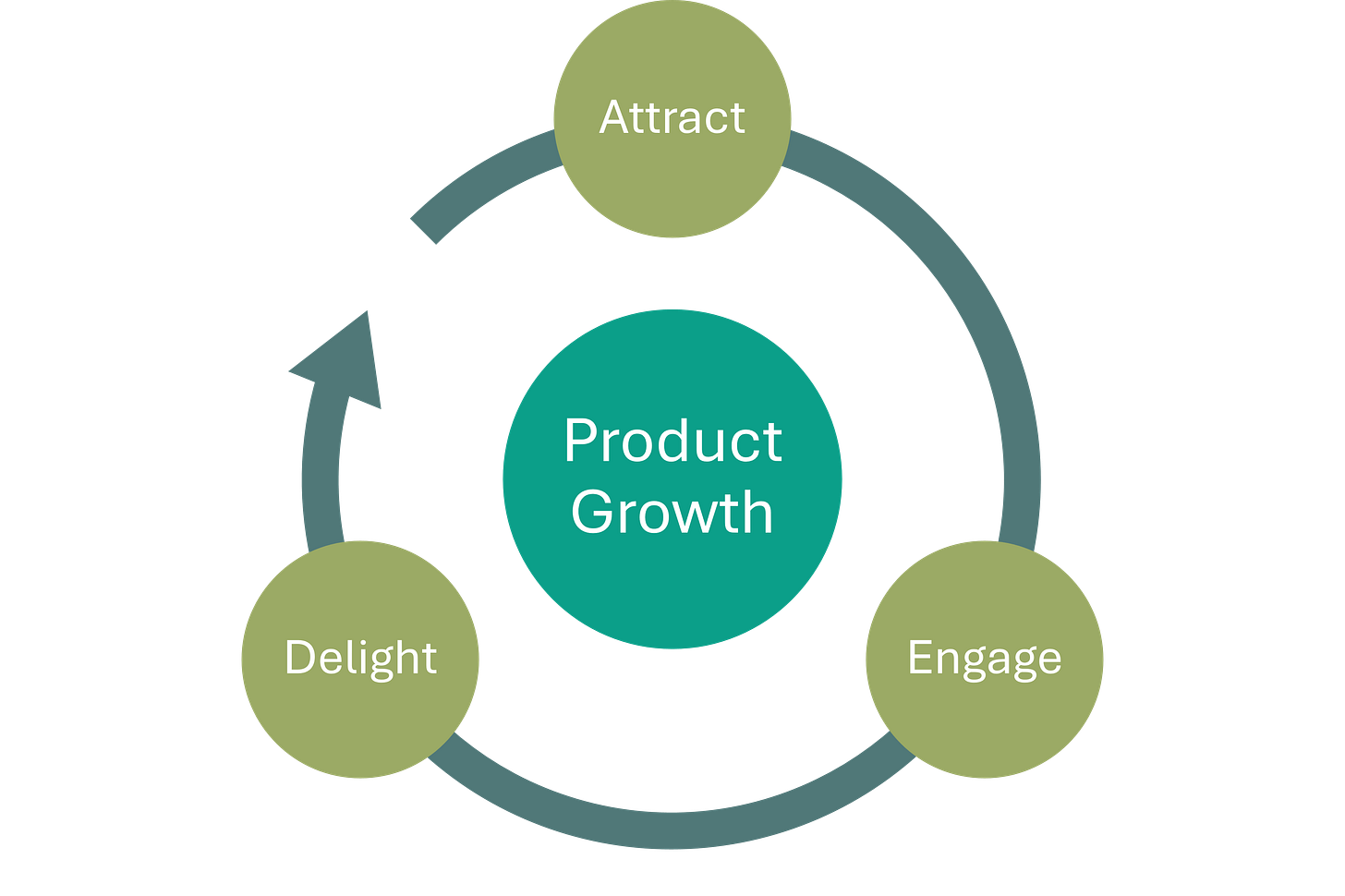Differing Approaches for Product Organizations
Compare and distinguish between Product Led (Sales), Product Centric, Product Operating Model and others
In the vast expanse of modern business, various organizational strategies offer distinct pathways to success. Like navigators charting unknown seas, business leaders must choose the best route to achieve their goals, navigating through a variety of structural and operational approaches. This exploration delves into different product-centric approaches, comparing them with traditional sales-focused strategies. It’s a short collection of knowledge to compare and distinguish between those approaches. but be aware: You do not simply choose, you have to consider the approach based on you market, your product and your needs.
North Star: Product Growth
Product Growth stands out. Product Growth is not a basic pattern, but a target to be reached in each product organization no matter if product led, product centric or even product oriented. It is about combining effort to grow the product and grow the business based on the product and its strategy. Often a growth model stands behind that is based on network effects, hooks and other pattern to grow a product exponentially.
For that topic feel free to read my article on how to achieve Product Growth from an organizational perspective:
Product Management Renaissance
This article was first published in a shortened version at Mind The Product and is based on a talk at Product People Conference in Cologne in September 2023. In a corporate realm, Sales and Marketing clashed in a communication crisis. Sales sold projects that didn't align with the product, which also didn't match Marketing's promises. Meanwhile, the prod…
Product Led
This approach is centered around the idea that the product itself is the main driver of customer acquisition, conversion, and retention. It focuses on creating a product that is so compelling in terms of value and user experience that it essentially sells itself. This strategy often involves building products with strong virality, usability, and word-of-mouth potential. No approach is integrated deeper with branding. This approach suites especially well with B2C and/or simple products that are not operationally critical, thus are not getting evaluated as extensively as business-critical software.
If this works out in the end, the growth can e exponential and partly uncoupled from the workforce behind. Also it targets some typical human behavior like the joy of self-education.
Embracing product-led design is like creating a magnetic field around your product, naturally drawing in customers.
To build the bridge to marketing methods and make the corresponding change in the overall process a bit more transparent, I like the RARRA-model. The originally model was called AARRR and put the typical sales-led-approach in the center. The idea of RARRA is to put the value at the beginning as the customers entry point.
Classic AARRR-approach
RARRA as the adaptation for Product Led
Also most of the times the idea is to understand monetization as something that happens after the customer is already engaged; instead of the other way around.
Classic Selling Process Process
Product Led Selling Process
To expand the realm of Product Led here’s a tip on a book not directly targeting the topic, but the pattern underneath exponential growth behind many product led companies:
Hooked: How to Build Habit-Forming Products, by Nir Eyal
Product Centric
Product centricity places the product at the heart of a company's strategy and operations. It's about prioritizing product development and innovation to meet customer needs and outpace competitors. While similar to being product-led, product centricity might rely on the product as driver for growing the business but not necessarily for acquisition, conversion, and retention. So a Product Led Company is also a Product Centric Company, but not the other way around.
Often Product Centricity is explained as the opposite of Customer Centricity. As a product should be oriented towards the market needs and not a single customer in many ways still the customer is in the center of nearly every aspect of a product. A better explanation is to think of product centricity as putting the product in the center as an element that combines the perspectives of customer needs, market relevance, user orientation, technical implementation and communication (in&out). This way it is an approach especially working out in the B2B and enterprise area, where classic sales capabilities have to be combined into Product Centricity.
In some ways the Product is an abstract construct defining what you strategically deliver, to whom, in what ways and so on.
Product centricity aligns every business orbit around the product, illuminating paths to innovation and market relevance.
Maybe the most important concept of product centricity is to create a recurring cycle of strategic value creation around a defined customer journey, instead of a linear process of customer satisfaction. Feel free to read my article on that topic:
The Triple Diamond
The Problem with the Problem Space You iteratively explore the customers problem space and find out how to solve that in the solution space. It’s easy as that -isn’t it? It doesn’t feel good to blindly build solutions how the customers wants them. This feeling was greatly described in the book
The Flywheel
I like the idea of creating a flywheel that is often described as a marketing method, but can also be seen as part of a product centric approach.
The Flywheel Method emphasizes a continuous cycle of engagement and improvement based on customer interactions. Unlike traditional funnel-based models that end with a purchase, the flywheel model views customer satisfaction and loyalty as central to driving referrals and repeat sales, thus keeping the momentum of sales going. The idea in combination with a product centric approach is to gradually attract the customer and bind it with low barriers in between the steps.
The flywheel was popularised by Brian Halligan (CEO of Hubspot), but is also a concept, you will find in the art of category design, see Play Bigger, by the authors Al Ramadan, Dave Peterson, Christopher Lochhead, and Kevin Mane.
Product Led Sales
As mentioned before, purely Product Led Companies are extremely rare in the B2B environment. It is simply not that often, that a product is not in need of explanation or has to be integrated into the customers architecture and organization in a manner that makes a direct customer contact worthwile. But there are more reasons that make additional sales efforts seem sensible.
Buying decisions in B2B, but especially within enterprises are complicated and often intransparent for providers. So individual research and adapted communication will potentially increase your conversion rate. If you are interested in some thoughts on buyer and user archetypes and how to document the interdependencies between them:
Operationally critical systems in B2B areas typically have margins that allow relatively high costs per customer.
A Product Led Sales approach will mean that unsuitable leads need to be rejected less frequently at the Product Qualification stage.
What Product Led Sales does in the end
Product Led sales simply means that the product is put in the center of thoughts together with the leads you are working on. You have to find the overlap between customer needs and the product's value proposition. The target is to automate as many aspects of the sales process within the product with the mentioned product led approach and add classical sales where needed.
Despite the naming Product Led Sales is well-combined with Product Centricity or it is the logic answer to a Product Led approach in the B2B area. So what does Product Led Sales add or change compared to a more conservative sales approach?
You listen to the customer and then you offer your solution
It is about finding out if there is a fit. I find this very similar to recruiting the right people for your team. The idea is neither to sell at all cost nor to place your product and wait for a response!Product Led Sales is much more aiming for values for the own company that are not revenue-based. Although revenue of course is still the purpose of selling a product, you should also aim for learnings and for chance to learn.
Sales does not simply throw customer requirements at the Product Management team, but actively work on growing the product strategically.
Data on B2B Product Led Sales
Pocus did a survey on the actual state of Product Led Companies in B2B and the data truly supports the idea of a strategic approach to Product Led Sales!
97% of companies have sales or plans to add sales on top of Product Led Growth
46% of companies leverage sales to nurture/convert PQLs
and so on
This means that the need for sales in product centric B2B companies is being recognized!
Product Oriented
A term that is not common. This is something added by myself as the author. I like to call the companies trying to make use of Product Management capabilities for their classic organization, "Product Oriented". Although this is often the bright idea of a positive development for organizational approaches that are often not sustainable in the future, these half-baked implementations are usually doomed to failure. Orienting towards a product centric approach is not done by implementing Product Management as a simple discipline.
However, this approach can work for companies that do not actually offer any products in the true sense of the word: Service companies. Taking responsibility for an actively managed service portfolio and thus making it more scalable works particularly well with product-oriented methods and approaches, if implemented knowing that this is in no means product centric or product led.
Product orientation in services is like solving a puzzle with a new set of rules - challenging but potentially transformative.
Product orientation lets out many approaches that make product centricity successful, like the flywheel approach and the understanding of the product as the central element of Business Development.
Product Operating (Model)
This is more about how an organization is structured and operates to support product development. It involves processes, governance, roles, and responsibilities focused on delivering product value. It's an organizational blueprint that defines how teams collaborate, how decisions are made, and how work flows in the pursuit of developing and managing products, especially in large enterprises.. Still it puts the product at the center of nearly everything and using partially the same methods.
The Product Operating Model is the architecture of success, ensuring every cog in the organizational machine works towards product excellence.
There is a narrow path between a beneficial formalization of basic methodology to keep different businesses within the enterprise compatible and an over-management, that’ll kill your agility and motivation. In the world of enterprises you still need to develop people and teams in a holacratic manner. There is no short cut through a doctrine by the upper management, if you want to stay competitive in the long run.
Product Anti-Pattern
Sales Led
A sales-led company is a business where strategic decisions and organizational culture are predominantly influenced by the sales department. This focus means that the company prioritizes sales growth and revenue generation as its primary objectives. In such organizations, development, marketing strategies, and customer relations are often oriented around maximizing sales opportunities and meeting sales targets. The sales team typically plays a key role in shaping the direction of the company, influencing both short-term tactics and long-term planning. This approach is totally fine and in no means something bad. But to grow exponentially and scale specific target topics you have to at least combine it with one of the other organizational forms.
Sales-led strategies are powerful, but in the pursuit of scaling new heights, they may need to harmonize with other organizational designs.
Service Oriented
Complete service orientation is often implemented in IT departments or for IT system vendors, yet more and more of these companies understand that at least having a strategic, common and defined understanding of the service (a product in my opinion) is very helpful.
Technology Driven
Especially as a startup or kind of a basic technology provider it might make sense to fully focus on the technology that is developed and not on the utilization for the purpose of creating revenue. Still I think there is always a customer and many of the disciplines of product centric companies can be useful.
Vision and Mission
Sometimes people come up with the category of vision or mission driven companies. I think that this in no means collides with the approaches mentioned before. The level of vision and mission orientation just differs between products, industries and businesses and can be accomplished with different product and non-product approaches.
Harmony in Diversity - A Conclusion
In conclusion, each organizational design approach offers unique benefits and challenges. The key is to understand your business's specific needs and goals, and to choose an approach that aligns with them. Whether it's letting your product lead the way, centering your strategy around it, orienting your services in a product-like manner, structuring your organization to support product development, or driving your business through sales, each approach offers a path to success. However, the most effective strategies often involve a harmonious blend of these models, tailored to the unique rhythm of your business. Remember, in the symphony of organizational design, it's the harmony between different notes that creates the most compelling melodies.




















